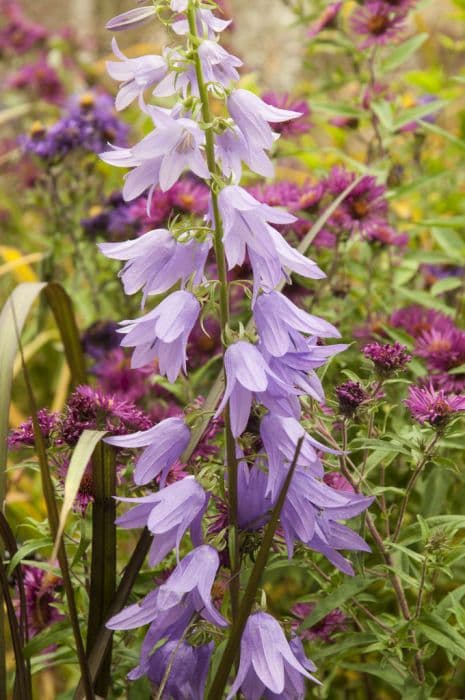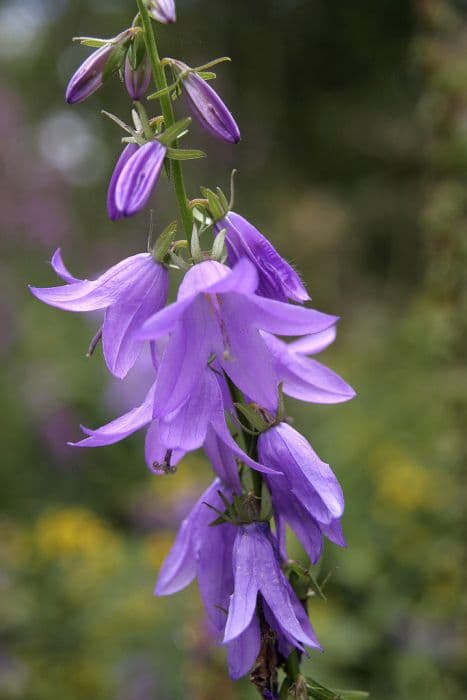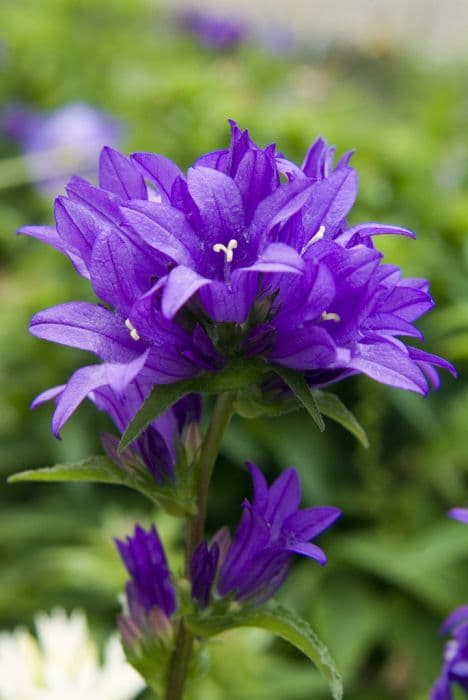Bellflower Campanula 'Birch Hybrid'

ABOUT
The Birch Hybrid bellflower is a perennial, eye-catching plant known primarily for its profusion of blooms. Its flowers are a striking violet-blue hue, bell-shaped, and they dangle gently from short stems, giving a charming cascading effect particularly when the plant is set at a higher elevation. This bellflower forms a dense mat of small, green leaves that are rounded to heart-shaped, creating a lush foliage backdrop for the radiant flowers. The leaves have a somewhat toothed edge giving them a delicate texture. The blossoms appear in abundance during the flowering season, transforming the plant into a vibrant cluster of color that can attract various pollinators like bees and butterflies. The plant has a tendency to bloom throughout the late spring and into summer, providing a long season of visual interest. The Birch Hybrid bellflower is often employed in garden designs as a groundcover or utilized in rock gardens and border fronts due to its appealing floral display and low-growing nature.
About this plant
 Names
NamesSynonyms
Birch Hybrid Bellflower, Birch Hybrid Campanula.
Common names
Campanula 'Birch Hybrid'.
 Toxicity
ToxicityTo humans
The bellflower, specifically the Campanula 'Birch Hybrid', is generally considered non-toxic to humans. Therefore, ingesting parts of this plant typically does not result in poisoning or adverse health effects. However, it is always advisable to avoid eating any plant material that is not confirmed as safe for consumption.
To pets
The bellflower, including the Campanula 'Birch Hybrid', is also generally recognized as non-toxic to pets, such as cats and dogs. Ingesting parts of this plant is unlikely to cause poisoning or serious health issues in pets. However, as with humans, it is best practice to prevent pets from consuming plants not specifically intended for their consumption.
 Characteristics
CharacteristicsLife cycle
Perennials
Foliage type
Semi-deciduous
Color of leaves
Green
Flower color
Blue
Height
6-9 inches (15-23 cm)
Spread
12-18 inches (30-45 cm)
Plant type
Herb
Hardiness zones
4
Native area
Europe
Benefits
 General Benefits
General Benefits- Low Maintenance: Requires minimal care once established, ideal for busy gardeners.
- Ground Cover: Spreads to form a dense mat that can suppress weeds and cover bare spots.
- Long Blooming: Features a prolonged blooming period from late spring to early fall.
- Attractive Flowers: Produces a profusion of violet-blue flowers that add color to the garden.
- Pollinator Friendly: Attracts bees, butterflies, and other beneficial insects, supporting biodiversity.
- Cold Hardy: Resilient in cooler temperatures and can thrive in USDA hardiness zones 4-7.
- Rock Gardens: Well-suited for rock gardens or alpine settings due to its compact growth habit.
- Border Plant: Ideal for use as an edging plant along walkways, borders, and garden beds.
- Container Gardening: Suitable for growing in containers on patios, balconies, or terraces.
- Tolerates Different Soils: Adaptable to a variety of soil conditions, though it prefers well-drained soil.
 Medical Properties
Medical PropertiesThis plant is not used for medical purposes.
 Air-purifying Qualities
Air-purifying QualitiesThis plant is not specifically known for air purifying qualities.
 Other Uses
Other Uses- Campanula 'Birch Hybrid', commonly known as bellflower, can be used as a natural dye for fabrics, giving a range of colors from greens to blues depending on the mordant used.
- The bellflower can serve as a companion plant in gardens, attracting beneficial insects that prey on pests and improving the overall health of the garden ecosystem.
- Pressed bellflower blooms can be used in craft projects, such as making bookmarks, greeting cards, or botanical wall art.
- Edible petals of the bellflower can be used to decorate salads, desserts, and drinks to add a touch of elegance and a mild floral flavor.
- Live bellflower plants can be arranged in a small water feature, adding aesthetic appeal and attracting pollinators with their bright and showy flowers.
- Dried bellflower can be used as part of potpourri mixes, lending its subtle fragrance and pleasant appearance to the blend.
- Bellflower can be used in a sensory garden, designed to provide tactile experiences, with its soft foliage and delicate blossoms.
- The bellflower's cascading habit makes it suitable for use in a living wall or vertical garden, adding dimension and color to urban spaces.
- Its vibrant flowers can be used as natural confetti for outdoor celebrations, as they are biodegradable and environmentally friendly compared to synthetic alternatives.
- Bellflower petals can be used as a natural food coloring in pastries and confectioneries to give a subtle blue or violet hue.
Interesting Facts
 Feng Shui
Feng ShuiThe Bellflower is not used in Feng Shui practice.
 Zodiac Sign Compitability
Zodiac Sign CompitabilityThe Bellflower is not used in astrology practice.
 Plant Symbolism
Plant Symbolism- Gratitude: Campanulas, commonly known as bellflowers, are often associated with gratitude, perhaps due to their delicate and gracious appearance.
- Constancy and Perseverance: The bellflower's ability to grow in difficult conditions symbolizes steadfastness and the will to endure.
- Humility: The bell-shaped flowers that bow down as they bloom represent humility in various cultural symbolisms.
- Unwavering Love: Bellflowers have been a symbol of unwavering love in some traditions, signifying an undying devotion to a partner.
- Hope: The bellflower is also connected to the feeling of hope, as its blooms push through the soil towards the light.
 Water
WaterFor the Dalmatian bellflower, water thoroughly whenever the top inch of soil feels dry to the touch, which may be approximately once a week, depending on environmental conditions. It’s essential to ensure that the soil is well-draining to prevent root rot. Provide enough water to saturate the root zone, typically around 1 gallon per watering for a medium-sized plant. During the growing season in spring and summer, the plant may require more frequent watering, but always check the soil moisture before watering. Cut back on watering in the winter months when the plant is not actively growing.
 Light
LightThe Dalmatian bellflower thrives in full sun to partial shade. It prefers at least six hours of sunlight per day, but can also benefit from some afternoon shade in hotter climates. The ideal spot for this plant is an area that receives bright, indirect sunlight, which will help promote vigorous flowering and healthy foliage.
 Temperature
TemperatureThe Dalmatian bellflower can withstand a wide range of temperatures and is winter-hardy to about -30 degrees Fahrenheit. However, it prefers a growing environment with daytime temperatures between 60 and 75 degrees Fahrenheit, which is conducive to healthy growth. Nighttime temperatures slightly cooler than daytime temperatures are ideal for this perennial.
 Pruning
PruningPruning the Dalmatian bellflower can encourage a bushier growth habit and more abundant blooms. Deadhead spent flowers regularly to promote continuous flowering. After the first flush of blooms, cut back the foliage by up to half to rejuvenate the plant and encourage a second bloom period. The best time to prune for overall shaping is early spring before new growth begins.
 Cleaning
CleaningAs needed
 Soil
SoilThe best soil mix for the Dwarf Bellflower, also known as Campanula 'Birch Hybrid', is well-draining soil with a mix of loam, peat, and sand. The pH level of the soil should be slightly acidic to neutral, ranging from 6.0 to 7.5. A good mix can be made with equal parts of garden soil, compost, and perlite or pumice to enhance drainage.
 Repotting
RepottingThe Dwarf Bellflower should be repotted every 2-3 years or when it becomes root-bound. The best time to repot is in the spring when the plant is entering a period of active growth.
 Humidity & Misting
Humidity & MistingThe Dwarf Bellflower prefers moderate humidity levels but is quite adaptable. It will thrive in average household humidity but ensure good air circulation to prevent any moisture-related diseases.
 Suitable locations
Suitable locationsIndoor
Place in bright, indirect light and water when topsoil is dry.
Outdoor
Plant in partial shade with moist, well-draining soil.
Hardiness zone
4-9 USDA
 Life cycle
Life cycleThe life of Campanula 'Birch Hybrid', commonly known as Dwarf Bellflower, begins with seed germination, where the seedlings emerge in favorable conditions of moisture, light, and temperature. Following germination, the seedlings establish a root system and produce initial leaves in a juvenile vegetative stage. The plant then enters a mature vegetative phase, growing into a low, spreading mound with deep green foliage. As it matures further, the Dwarf Bellflower enters the flowering stage, producing a profusion of violet-blue, bell-shaped flowers throughout the summer months. After pollination, the plant sets seed, which can disperse and lead to new plants, completing the reproductive cycle. The Dwarf Bellflower is a perennial, which will undergo periods of dormancy in the winter before resuming growth in the spring.
 Propogation
PropogationPropogation time
Spring to Summer
The Campanula 'Birch Hybrid', commonly known as Dwarf Bellflower, is typically propagated through division, which is the most popular method for this perennial plant. The best time to propagate by division is in the spring or early fall. To propagate Dwarf Bellflower through division, carefully lift the parent plant from the ground using a garden fork, ensuring you take a good amount of root system with it. Gently separate the plant clumps into smaller sections, each with a portion of roots attached, making sure that each new section has at least one healthy shoot. Replant these divisions immediately at the same depth they were growing previously, spacing them about 12 inches (approximately 30 centimeters) apart to allow for growth and adequate air circulation. After planting, water the divisions thoroughly to help establish the new plants.








